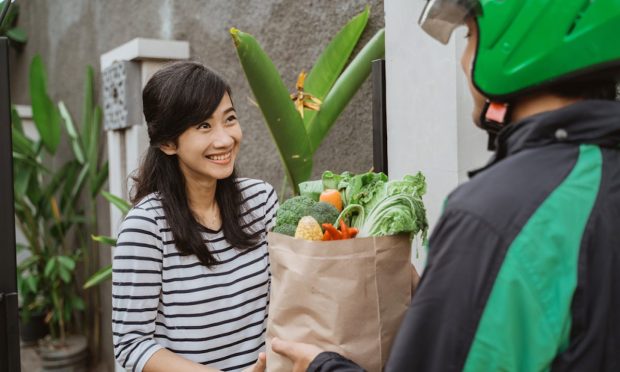Uber Reigns In Restaurant Delivery, Eyes Grocery Growth

Uber Eats might be winning the food delivery race. On Wednesday (Aug. 4), the company revealed in a presentation shared with analysts that its delivery business totaled $52 billion in annualized gross merchandise value (GMV) in the second quarter of 2021, which was split about evenly between bookings from the United States and Canada and bookings from the rest of the world, and was higher than any of the company’s global competitors.
You might also like: Uber’s Q2 Rebound Driven By Costly Re-Staffing Prior To COVID Delta Concerns
Meanwhile, competitor Just Eat Takeaway.com announced when it reported its Q2 results that the company’s gross transaction volume (GTV) for the full year 2021 is expected to be between $33 and $36 billion. Per Uber’s presentation, it is estimated that Delivery Hero, which has not yet reported its Q2 results, will bring in $39 billion in GMV, and that DoorDash, which has also not yet reported, will also generate $39 billion in gross order volume (GOV). Additionally, the presentation highlights that Uber’s 85 percent year-over-year GMV growth outpaces all its top competitors. The company noted that Uber Delivery is a category leader in eight out of 10 of its top markets, coming in second in the U.S. and the U.K.
You may also like: Active Delivery Merchants For Uber Eats Surge 76 Pct YoY
Regarding the delivery business’ expansion from restaurant meal delivery to include liquor and grocery delivery, the company’s CEO Dara Khosrowshahi told analysts on a call, “Grocery and Drizly are very, very close to our delivery business in terms of use cases. They cover the fast and frequent. People want their liquor fast, they want grocery fast, and they’re also frequent use cases as well.”
Khosrowshahi noted that “in the last few weeks,” the company has grown its grocery delivery footprint twofold to now be available in 400 cities, adding that grocery is “the next pillar of growth for Uber.” In the U.S. market, he conceded that Instacart “is a really strong competitor.”
See also: Uber Eats Devours Rideshare Business As Company Doubles Up On Groceries
Discussing Uber’s strategy to take on the e-grocery giant, Khosrowshahi noted that through its ridesharing and its existing delivery businesses, the audience can reach “a bigger audience than anyone else has,” adding that its near-term goal with the U.S. grocery business is to add more grocers to the platform.
Read more: India’s Zomato Touts New Investment In Pivot Back To Grocery Delivery
All around the world, delivery services that began with restaurant meals are making moves into the grocery space. Last month, India-based restaurant delivery service Zomato announced its grocery intentions, following on DoorDash’s announcement of its partnership with major U.S. grocer Albertsons and on Just Eat Takeaway.com’s move to debut grocery delivery in the competitive German market.
It is no wonder, given the centrality of eating to consumers’ daily routines and the shift toward digital convenience in all parts of people’s lives. Consumers are ordering more groceries online than ever before. In fact, PYMNTS data collected in May found that as many people are ordering groceries online as are ordering restaurant meals online.
See also: The Instacart Way To Innovating In The Connected Economy
As Karen Webster wrote earlier this year, “This Eat ecosystem — how consumers buy and pay for their food and where they eat it — is quickly becoming one of the most fascinating case studies for how connected economies develop, compete and scale.”